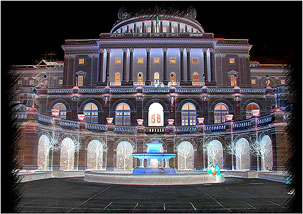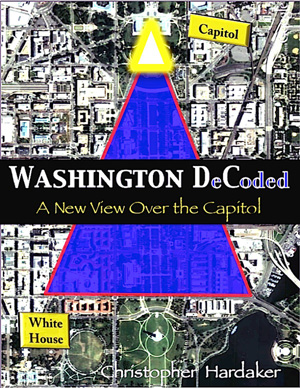
Christopher Hardaker, M.A.,University of Arizona, has been a prehistoric archaeologist, prehistorian and educational consultant for over thirty years. He is also author of The First American: The Suppressed Story of the People Who Discovered the New World, 2007. |
Who really designed
the National City?
With over 70 pages of illustrations, Washington DeCoded: A New View Over the Capitol offers an unforgettable tour of Washington, D.C. and introduces a new national mystery of grand proportions.
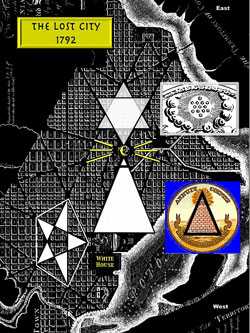
|
WASHINGTON DeCoded:
A New View Over the Capitol
Amazon Kindle
Lulu Marketplace
National symbols
in the streets
of Washington, D.C.
Willits, California, May 15, 2012
Washington DeCoded: A New View Over the Capitol is a ride through the streets of the Capital City.
National symbols from the Great Seal of the United States were embedded into the 1792 design for Washington, D.C. You will discover the following hiding in plain sight:
Using the strict rules of Sacred Geometry, Hardaker discovers a hidden dimension of the city’s design, introducing the reader to an unsolved national mystery.
Who embedded the Great Seal of the United States into the streets and avenues of the plan for Washington, D.C?
The Great Seal’s symbols were laid out along the east-west axis of the city. They are in the modern city. Some have been enhanced, others possibly added. The Star north of the White House held its own secrets. The ‘street symbols’ are scientific facts—mathematically accurate features within a degree of perfection. This approach to city design is simply unprecedented.
WHO inserted these national symbols into the original design for Washington, D.C? President George Washington? Thomas Jefferson? Alexander Hamilton? Andrew Ellicott, the President’s surveyor? It was certainly not Major Pierre L’Enfant, who originally mapped out the design in 1791. When he first looks upon the Planning Commission’s revision of his design, this is what he writes to President Washington.
[The plan is] now in a state in which it is most unmercifully spoiled and altered from the original plan to a degree indeed evidently tending to disgrace me and ridicule the very undertaking. Pierre L'Enfant
This “unmercifully spoiled and altered” revision became Washington, D.C. L’Enfant’s role was not known until the 1880s, his name removed from the 1792 document. Credit was given to Andrew Ellicott. Why? And does the answer to that question lead to the much larger and incredible question: Who inserted national symbols from the Great Seal of the United States into the central heart of Washington, D.C?
With over 70 pages of illustrations, Washington DeCoded: A New View Over the Capitol offers an unforgettable tour of Washington, D.C, and introduces a new national mystery of grand proportions: Who really designed the National City, and what is the design’s true creative dimension?
Download free sample chapters.
|
|
An Adventure in Sacred Geometry
REVIEW
“Having recently read Chris Hardaker's Washington Decoded, I have to say that anyone interested in an historical quandary is in for a treat with this one. I had heard for years that Washington, D.C., not only had considerable links to Freemasonry, but also contained somewhat 'in your face' images within the design plan of the District that were sacred to the Masons (if not the 'Ancients', whoever they may be!).
“I was not, however, prepared for the totality of images that leap from the layout of the city, and the fact that 'stretches of the imagination', and 'leaps of faith' are not required to appreciate their presence: they're there, and when they're shown to you, there's almost no doubt that mere coincidence is not involved.
“What really sets this work off, however, is the incredible detail put into what I'd have to call a 'beginner's guide to sacred geometry' (Sacred Geometry for Dummies?). … A more complete understanding of what covers the District of Columbia pretty much requires such introductory treatment, but rarely does an author bother to actually do it! The absolute elegance of how circles, polygons and other geometric figures intimately interact (while initially appearing unrelated), is pretty mind-boggling...and it extends far beyond a treatment for the layout of a city. While the figures of the city are clearly shown, the examples of basic sacred geometry are almost more stimulating. It's a down-right tutorial, in the simplest techniques, of understanding this area of mathematics …
“Historians (or just history 'buffs'), mathematicians (or just math 'buffs'), mystery-seekers, or those just looking for a stimulating read, it's all here.”
Allan N. Spreen, MD
|
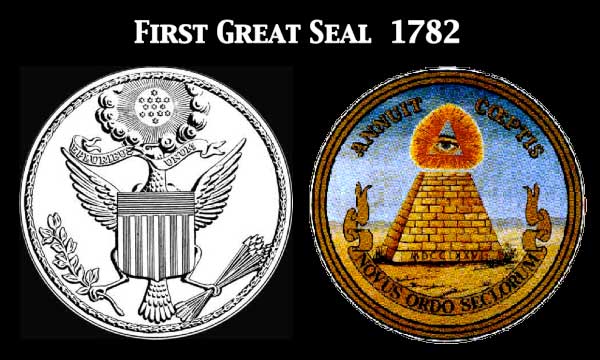
from The Power of Myth (1988),
Joseph Campbell and Bill Moyers
discuss the Pyramid symbol on the Great Seal.
CAMPBELL: No, no, you have to distinguish between reason and thinking.
MOYERS: Distinguish between reason and thinking? If I think, am I not reasoning things out?
CAMPBELL: Yes, your reason is one kind of thinking. But thinking things out isn’t necessarily reason in this sense. Figuring out how you can break through a wall is not reason. The mouse who figures out, after it bumps its nose here, that perhaps he can get around there, is figuring something out the way we figure things out. But that’s not reason. Reason has to do with finding the ground of being and the fundamental structuring of order of the universe.
MOYERS: So when these men talked about the eye of God being reason, they were saying that the ground of our being as a society, as a culture, as a people, derives from the fundamental character of the universe?
CAMPBELL: That’s what this first pyramid says. This is the pyramid of the world, and this is the pyramid of our society, and they are of the same order. This is God’s creation, and this is our society.
|
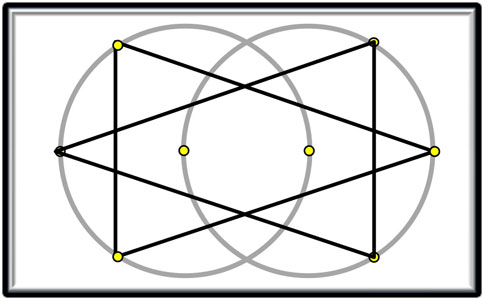
|
|

